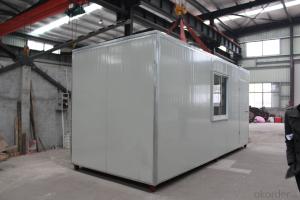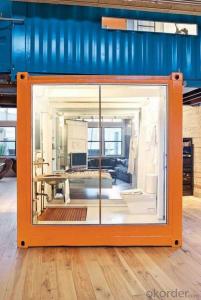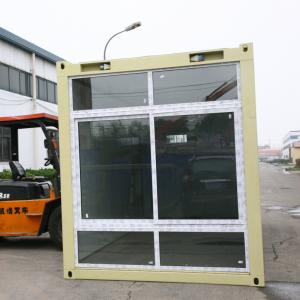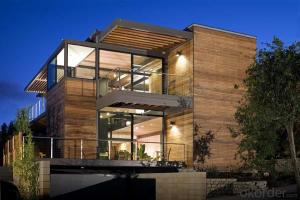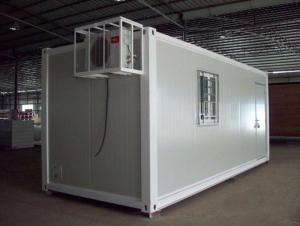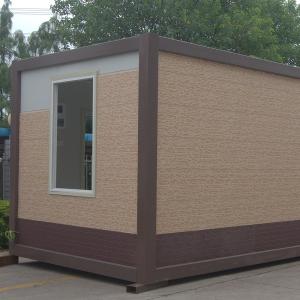Easy installation container house
- Loading Port:
- China Main Port
- Payment Terms:
- TT OR LC
- Min Order Qty:
- -
- Supply Capability:
- -
OKorder Service Pledge
OKorder Financial Service
You Might Also Like
Our advantages:
1. Qualification: CE(DIN18800), ISO9001, BV
2. Durable, beautiful, economic and environmental
3. High Construction Efficiency (2 worker in one day for one unit)
4. Long life time (Max. 20 years)
5. Easy to transport and assemble (Can load 7 units into one 40'HQ)
Brand Name: PTH
Our advantages:
1) Integrated base and roof, PU injected, excellent strength and tightness
2) 0.426mm color steel sheet for sandwich wall panel, strong and beautiful
3) All electric wires, water pipes, windows, doors and floor pre-setted, easy for assembling
4) Long time oversea project experience
5) 4S sales and service network, buy a house just like to buy a car
| standard | roof load | 0.5KN/sqm (can reinforce the structure as required) |
| Wind speed | designing wind speed: 210km/h (Chinese standard) | |
| seismic resistance | magnitudes 8 | |
| temperature | suitable temperature.-50°C~+50°C |
Usage: The small container house has the following features: light weight, convenient and fast assembling and shipment, many-times disassembling, high rate of reuse. It can be applied to office, command posts, dormitories, meeting rooms, warehouses, shops, additional storey on building roof and temporary houses in the field of building, railways, highways, water conservancy projects, electric power, oil, business, tourism, and military use. And the houses are air-tight, heat-insulating, warm-keeping, waterproof and anti-corrosive.
1. Easy to assemble and disassemble: The houses can be assembled and disassembled for dozens of times and can be reused for many times. And the assembling only needs simple tools and doesn’t need power source. The connections of the pieces of the house all adopt plugs or screw connections.
2. Strong Structure: It adopts steel frame structure, therefore it is stable and in line with the designing code of building structure.
3. Heat-insulation: The roof and wall are made of color steel sandwich panel (EPS, XPS, PU or Rock Wool) which have good heat-insulating and fire-proof performance.
4. Durable: The steel frame parts are all processed with anti-corrosion coating and it can be used as long as 20 years.
5. Environment protection: The design of the house is reasonable and it is easy to assemble and disassemble.
6. Diversified Specifications: Our design can be customized. The doors, windows and front and back walls can be exchanged each other. And the partition walls according to the customers’ requirements.
- Q:Can container houses be designed with a built-in storage system?
- Certainly, it is entirely possible to design container houses with an integrated storage system. Indeed, one of the benefits of utilizing shipping containers for housing lies in their inherent storage capacity. The containers' large and robust structure permits the implementation of imaginative and efficient storage solutions. Designers and architects have the ability to include a variety of storage options within container homes, such as inbuilt shelves, cabinets, and closets. These storage systems can be tailored to suit the specific requirements and preferences of the homeowner. By employing wall-mounted storage units or constructing built-in loft spaces, the vertical space within the containers can be maximized. Furthermore, container houses can also boast innovative storage solutions that cleverly utilize the unique characteristics of the containers. For instance, certain designs incorporate sliding panels or concealed compartments within the walls or floors of the containers, providing additional storage space without compromising the aesthetic appeal of the home. All in all, container houses offer immense potential for integrating a built-in storage system, enabling homeowners to optimize the available space and maintain a neat and organized living environment.
- Q:Can container houses be designed with a rustic or industrial look?
- Yes, container houses can definitely be designed with a rustic or industrial look. The modular nature of container homes allows for endless possibilities when it comes to exterior and interior design. With the right materials, finishes, and design elements, container houses can easily achieve the rustic or industrial aesthetic. For a rustic look, natural materials such as reclaimed wood or stone can be incorporated into the design. Exposed beams, distressed finishes, and earthy color palettes can also contribute to the rustic charm. Additionally, incorporating elements like barn doors, vintage lighting fixtures, and antique furniture can enhance the overall rustic feel of the container house. On the other hand, an industrial look can be achieved by using materials like metal, concrete, and glass. Exposed steel beams, corrugated metal siding, and concrete walls can create an industrial vibe. Incorporating minimalist design elements, such as clean lines, open spaces, and functional furniture, will further enhance the industrial aesthetic. It's important to note that while container houses can be designed with a rustic or industrial look, the final outcome will depend on the creativity and vision of the designer. With the right combination of materials, finishes, and design choices, container houses can successfully embrace the desired aesthetic.
- Q:Can container houses be designed to have an open floor plan?
- Yes, container houses can definitely be designed to have an open floor plan. In fact, the modular nature of container homes makes them particularly suitable for creating open and flexible living spaces. With proper design and engineering, walls, partitions, and other structural elements can be eliminated or repositioned to create a seamless and spacious interior layout. Container houses can be customized to meet specific requirements, allowing for the creation of open floor plans that prioritize natural light, flow, and functionality. By strategically placing windows, skylights, and glass doors, container homes can maximize the use of natural light and create a sense of openness. Moreover, container homes can be expanded by joining multiple containers together, further enhancing the potential for an open floor plan. This allows for the creation of larger living spaces, such as open-concept kitchens and living rooms. However, it is important to consider the structural integrity of the container when designing an open floor plan. Proper reinforcement and support may be necessary to ensure the stability and safety of the structure. Consulting with a professional architect or engineer who specializes in container house design is essential to ensure that the open floor plan is well-executed and meets all necessary building codes and regulations. Overall, container houses offer great flexibility in design, making it entirely possible to achieve an open floor plan that suits your preferences and lifestyle.
- Q:Can container houses be connected to municipal utilities?
- Yes, container houses can be connected to municipal utilities. They can be easily connected to electricity, water, and sewage systems, just like traditional houses.
- Q:Do container houses require a building permit?
- Yes, container houses generally require a building permit. The requirement for a building permit varies depending on the location and local regulations. In most jurisdictions, any structure that is intended for habitation or permanent use, including container houses, must comply with building codes and obtain the necessary permits. These permits ensure that the structure meets safety standards, zoning requirements, and other regulations. It is important to consult with local authorities or a professional architect to determine the specific requirements and obtain the appropriate permits before constructing a container house.
- Q:Are container houses suitable for urban areas?
- Yes, container houses are suitable for urban areas. With the increasing population and limited space in urban areas, container houses offer a practical solution for affordable housing. These houses are made from recycled shipping containers, which helps reduce waste and promote sustainability. They can be easily constructed and customized to fit within the available space, making them ideal for urban settings where land is scarce. Additionally, container houses are portable and can be easily moved to different locations if needed. They can also be stacked or combined to create multi-level structures, maximizing the use of vertical space. Furthermore, container houses can be designed with modern aesthetics and amenities, providing a comfortable living environment for urban dwellers. Overall, container houses offer a cost-effective, environmentally friendly, and flexible housing option for urban areas.
- Q:Are container houses suitable for pet-friendly living?
- Container houses can definitely be suitable for pet-friendly living. One of the great advantages of container houses is their versatility in design and customization. With proper planning and design, container houses can provide a comfortable and safe environment for pets. Containers can be easily modified to include pet-friendly features such as spacious and secure outdoor areas, designated pet play areas, and even built-in pet-friendly furniture or storage solutions. The ample space in containers also allows for the inclusion of pet amenities like litter boxes, pet beds, or even a small indoor pet area. Furthermore, container houses can be equipped with proper insulation, ventilation, and climate control systems to ensure the comfort of pets, regardless of the weather conditions. This is particularly important for pet owners who live in extreme climates or areas prone to temperature fluctuations. In terms of safety, container houses can be made pet-proof by incorporating secure fences or gates around the outdoor areas, as well as implementing sturdy windows and doors. It is also possible to design the layout in a way that prevents pets from accessing certain areas or hazards within the house. Additionally, container houses are often located on private properties, which can offer more freedom and privacy for pets. This means that pets can enjoy outdoor spaces without worrying about encountering other animals or strangers. However, it is crucial to consider the specific needs and habits of your pets before choosing a container house. Some pets may require larger outdoor spaces, while others may have specific needs that need to be accommodated. In conclusion, container houses can be an excellent choice for pet-friendly living, as they offer the flexibility to create a comfortable and safe environment for pets. With the right design and customization, container houses can provide all the necessary amenities and features to ensure the well-being of your furry friends.
- Q:Can container houses be designed with a small garden or outdoor space?
- Yes, container houses can certainly be designed with a small garden or outdoor space. The versatility of container houses allows for creative design options, including incorporating outdoor areas such as rooftop gardens, balconies, or patio spaces. These additions not only enhance the aesthetics of the house but also provide residents with a refreshing outdoor retreat.
- Q:Can container houses be insulated for better temperature control?
- Yes, container houses can be insulated for better temperature control. Insulation plays a crucial role in maintaining a comfortable indoor temperature by reducing heat transfer between the interior and exterior of the container. There are several insulation options available for container houses, such as spray foam insulation, rigid foam insulation, and reflective insulation. These materials can be applied to the walls, roof, and floor of the container to minimize heat loss or gain. Additionally, insulating windows and doors can also contribute to better temperature control. By properly insulating a container house, one can significantly improve its energy efficiency and create a more comfortable living environment regardless of the external weather conditions.
- Q:How is the container housing made and installed?
- The general modification of the box are pulled directly from the trailer to place the place, hanging with a crane to put the location on the line
1. Manufacturer Overview |
|
|---|---|
| Location | |
| Year Established | |
| Annual Output Value | |
| Main Markets | |
| Company Certifications | |
2. Manufacturer Certificates |
|
|---|---|
| a) Certification Name | |
| Range | |
| Reference | |
| Validity Period | |
3. Manufacturer Capability |
|
|---|---|
| a)Trade Capacity | |
| Nearest Port | |
| Export Percentage | |
| No.of Employees in Trade Department | |
| Language Spoken: | |
| b)Factory Information | |
| Factory Size: | |
| No. of Production Lines | |
| Contract Manufacturing | |
| Product Price Range | |
Send your message to us
Easy installation container house
- Loading Port:
- China Main Port
- Payment Terms:
- TT OR LC
- Min Order Qty:
- -
- Supply Capability:
- -
OKorder Service Pledge
OKorder Financial Service
Similar products
New products
Hot products
Hot Searches
Related keywords
